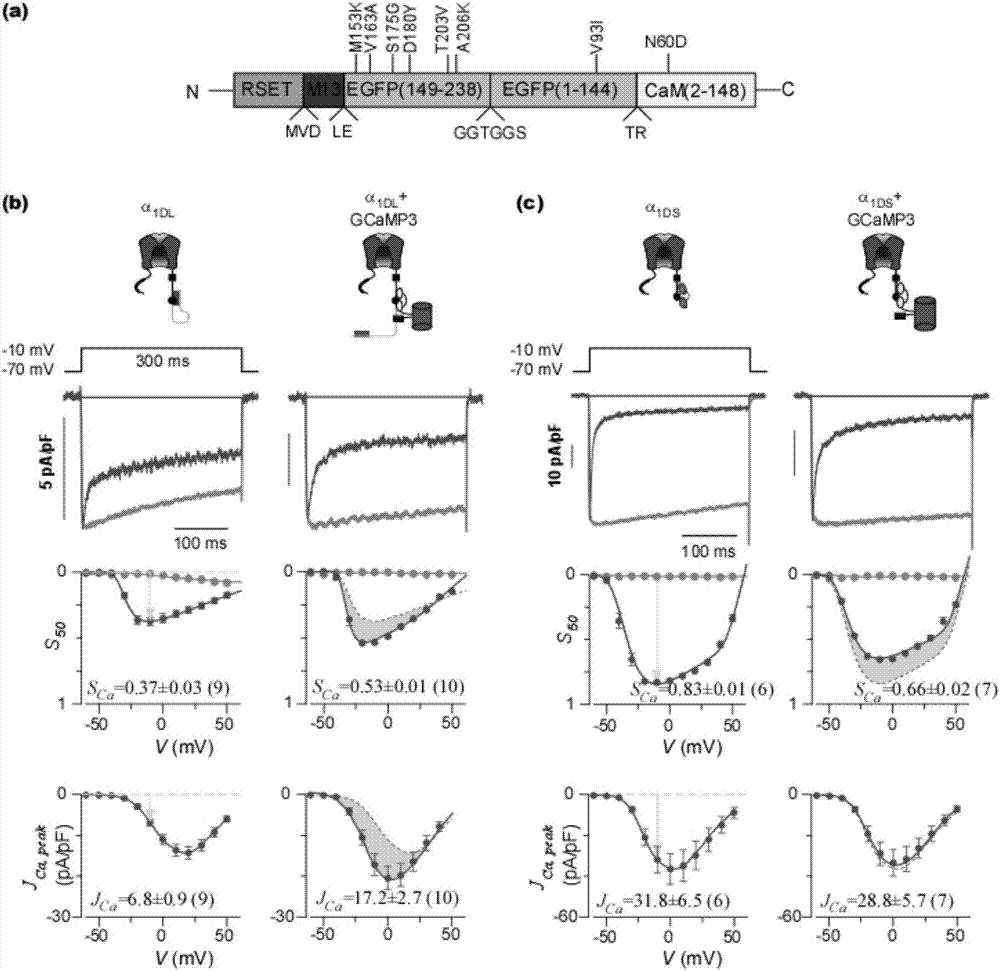Design and application of gene coding calcium probe GCaMP-X
A gene-encoded, calcium ion technology, applied in the field of calcium ion concentration indicators, can solve problems that need to be optimized
- Summary
- Abstract
- Description
- Claims
- Application Information
AI Technical Summary
Problems solved by technology
Method used
Image
Examples
Embodiment 1
[0056] Example 1: Research on the relationship between the degree of nuclear aggregation of GCaMP3 and the morphology of corresponding neurons
[0057] At present, many studies have found and reported that when GCaMP is long-term or overexpressed in neurons by virus infection or electroporation, the fluorescence distribution of GCaMP tends to accumulate to the nucleus, and the cell morphology, physiological function and GCaMP monitors Ca 2+ performance will change.
[0058] Therefore, the inventors transfected the fluorescent protein YFP and GCaMP3 plasmids into isolated and cultured cortical neurons, and after 2 days of plasmid expression, the degree of nuclear accumulation of GCaMP3 (the nucleocytoplasmic ratio of GCaMP3 fluorescence N / C ratio) and the corresponding neuron Morphology (total neurite length) was quantified. see results figure 1 .
[0059] Such as figure 1 Shown, (a) Neurite tracking diagrams of representative neurons of fluorescent protein YFP control gro...
Embodiment 2
[0061] Example 2 Study on the Mechanism of GCaMP's Damage to Neurons
[0062]Based on the fact that CaM can participate in and regulate the excitation-transcription coupling of neurons, the inventor speculates that the damage effect of GCaMP on neurons is mainly due to the CaM contained in itself, and that GCaMP can change the gating-signal of LTCC and affect CREB-related gene transcription process.
[0063] First, in order to verify that GCaMP will affect the gating characteristics of LTCC, the inventors used a cell line expression system to conduct experiments, combining GCaMP3 with the carbon-terminal complete Ca V 1.3 channels (α 1DL ) or Ca at the short carbon end V 1.3 channels (α 1DS ) co-expressed in HEK293T cells, using the parameter S Ca (such as S 50Ca =1-I 50Ca / I peakCa , where I 50Ca is the calcium current when the voltage is activated for 50ms, I peakCa is the spike calcium current within 300 ms of voltage-sustained activation) to measure the CDI streng...
Embodiment 3
[0073] Example 3 GCaMP-X and GCaMP3-X C Preparation and effect testing
[0074] The results of Examples 1-2 indicate that existing GCaMPs need to be optimized. Based on the competitive relationship between apo-CaM and the DCT domain of LTCC, the optimization of GCaMP3 can be achieved by introducing a fragment (CaM Binding Motif, CBM) that can weaken the ability of apo-CaM to channel pre-binding. Connecting CBM directly to GCaMP3 is beneficial to the combination of the two in terms of spatial position, which can weaken the pre-binding ability of GCaMP3 and LTCC, and avoid its interference on the gating characteristics of LTCC.
[0075] At the same time, the inventors have also used a special positioning sequence, namely the nuclear export signal (Nuclear ExportSignal, NES) sequence (sometimes also called "nuclear export sequence"), which can bind to the nuclear export receptor in the cell, Export the associated protein to the cytoplasm, further ensuring that the optimized GCa...
PUM
 Login to View More
Login to View More Abstract
Description
Claims
Application Information
 Login to View More
Login to View More - R&D
- Intellectual Property
- Life Sciences
- Materials
- Tech Scout
- Unparalleled Data Quality
- Higher Quality Content
- 60% Fewer Hallucinations
Browse by: Latest US Patents, China's latest patents, Technical Efficacy Thesaurus, Application Domain, Technology Topic, Popular Technical Reports.
© 2025 PatSnap. All rights reserved.Legal|Privacy policy|Modern Slavery Act Transparency Statement|Sitemap|About US| Contact US: help@patsnap.com



